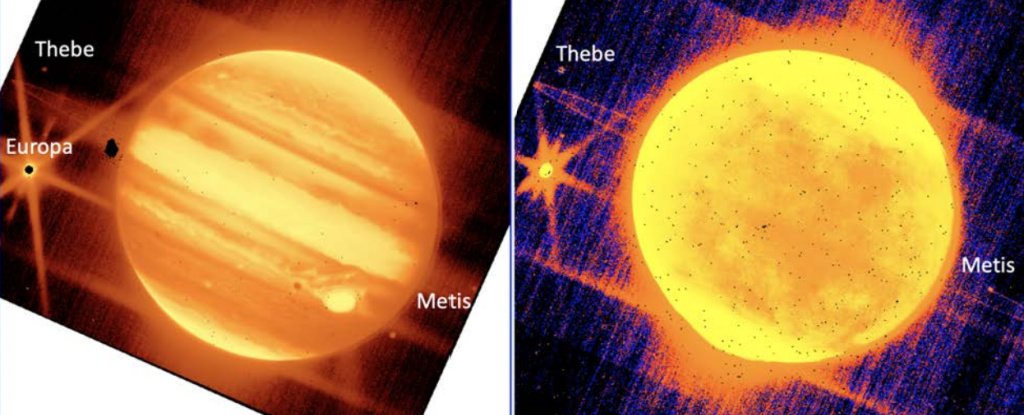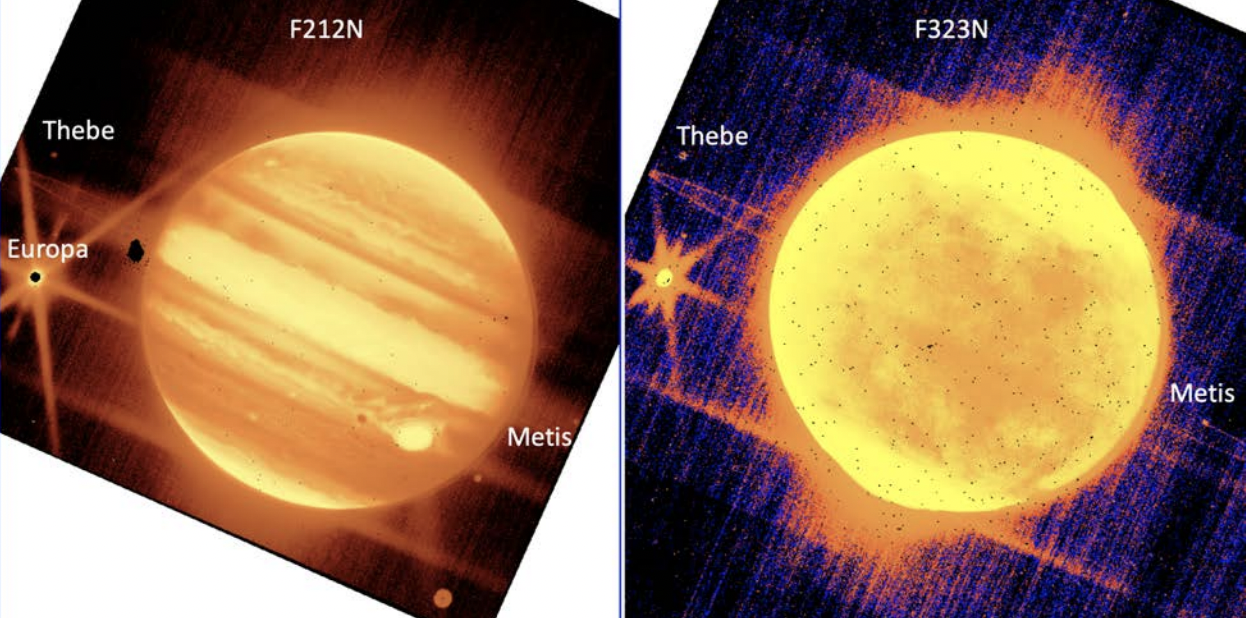
Posted on 07/13/2022 9:00:43 AM PDT by Red Badger

(NASA, ESA, CSA, and STScI)
This morning we were in a frenzy over a sneaky side-glimpse of a galaxy revealed in the first full-color James Webb Space Telescope (JWST) images.
But if you thought that was wild, then wait for this: it turns out JWST has also dropped some stealthy images of Jupiter! And they're ridiculously beautiful.
These images, taken while JWST was being tested, were provided in the JWST commissioning report.
umm who else saw this in the commissioning report document?? 😍😍😍😍🤯🤯🤯🤯🤯https://t.co/AzwQCf6rat pic.twitter.com/nq13fxdsAM
— Erin M. May, PhD (@_astronomay) July 12, 2022 The images, which you can see in greater detail below, show Jupiter and its rings as well as three of its moons: Europa, Thebe, and Metis.
You can also see the shadow of Europa in the image on the left, just next to the planet's tumultuous and infamous Great Red Spot.

Screen Shot 2022 07 13 at 11.58.42 am (NASA, ESA, CSA, and STScI)
Above: The image on the left was taken by the JWST Near-Infrared Camera using a filter that highlights short wavelengths. The image on the right is taken with a filter that highlights long wavelengths of light.
The images were taken by JWST's Near-Infrared Camera (NIRCam) and they use two different filters which highlight separate wavelengths of light.
Part of the test was ensuring that JWST could track fast-moving objects through the Solar System.
For this, JWST photographed nine targets, and Jupiter was the slowest moving – but, as you can see, one of the most stunning.
The test also showed that it's possible to use JWST to photograph details like moons and rings around a planet as bright as Jupiter.
"Observing a bright planet and its satellites and rings was expected to be challenging, due to scattered light that may affect the science instrument employed, but also the fine guidance sensor must track guide stars near the bright planet," the commissioning report explains.
"These observations verified the expectation that guide star acquisition works successfully as long as Jupiter is at least 140" away from the FGS, consistent with pre-flight modeling."
This is all good news as it means JWST will be useful at tracking things like near-Earth objects and comets.
Overall, the commissioning report shows that JWST is performing even better than expected.
"The key outcome of six months of commissioning is this: JWST is fully capable of achieving the discoveries for which it was built. JWST was envisioned 'to enable fundamental breakthroughs in our understanding of the formation and evolution of galaxies, stars, and planetary systems'," the authors write in the report.
"We now know with certainty that it will."
We're looking forward to more photo drops in the coming weeks and months!
Beat me to it.
We'll be The Pirate Twins again..
LOL, thanks. I needed a good laugh.
It’s the one that “astronomers don’t want you to know about.”<<<
“Especially for stars born before 1952.” :)
Yep.
What’s Webb’s “one weird trick”?
—
;-)
King George III? I was just watching a presentation about King George villified in history as the King who “lost the colonies”. The Brit author gave some good arguments that he accepted the independence of the US in good terms.
So where’s Carl Sagan?
_________________
Still waiting for that nuclear winter thing somewhere, not sure of his actual location right now.
Yes King George III
Specially named “Georgium Sidus” (the “Georgian Star”)
https://knowledgenuts.com/uranus-had-a-different-name-for-70-years/
Snobs didn’t like a relative amateur who got above his station by doing actual science getting to name things, so they changed the name.
Me, I call it George
Excellent!
Fantastic engineering, production, and operation...
Now, let’s hope that the science, over the next few years, will be just as stunning...
While the JWST experimental device is brilliant in its conception and implementation, it is the caliber of today’s computer-addicted scientists that gives me a little concern...
The past 40-years of scientific drought in the fundamental sciences has been driven, in part, by scientists who rely on stumbling onto something from extensive computer analyses rather than original thought generated between their ears...
A computer is just a tool.
How one uses that tool is what makes for discovery...............
They’re just aiming sensors at known objects to gauge their response and make calibrations when looking at deep space.
IOW, they had to launch the $9 billion JWST into space to see what’s in it. /s
I’m a supporter of pure science but putting the equivalent of an aircraft carrier in terms of capital expense where it could never be repaired (300% the expenditure for Hubble) is just stupid.
Your government spends multiple trillions on “Compassionate wars” and routinely gives away hundreds of billions to foreign countries all over the planet, but you’re complaining about 8 billion spent on science/JWST?
C’mon.
Bush spend 3+ trillion on his 10 year long compassionate war.
1 trillion equals 1,000 billion...So just one idiot in the White House spent 3,000 billion and we won NOTHING.
But 9 billion for James Webb telescope is outrageous....What a hoot!
I hope you forgot your sarc tag.
That was in regards to your, “Aircraft carrier expense” comment, as much as it was a general comment. I like to put things in perspective.
Again, I hope you had forgotten your sarc tag.
I never use sarcasm tags. I’m a fan deadpan humor.
It read that way, but sometimes on FR it’s hard to tell, ya know?
Disclaimer: Opinions posted on Free Republic are those of the individual posters and do not necessarily represent the opinion of Free Republic or its management. All materials posted herein are protected by copyright law and the exemption for fair use of copyrighted works.